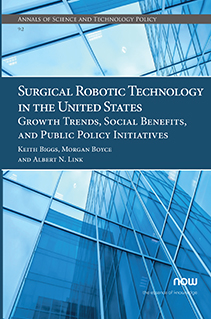Surgical Robotic Technology in the United States: Growth Trends, Social Benefits, and Public Policy Initiatives
By Keith Biggs, HealthTrust, USA, james.biggs@healthtrustpg.com | Morgan Boyce, University of North Carolina at Greensboro, USA, mkboyce@uncg.edu | Albert N. Link, University of North Carolina at Greensboro, USA, anlink@uncg.edu
Abstract
This monograph details the evolution, growth, and diffusion of surgical robotic technology in the United States and globally. It begins with a historical overview of the development of surgical robots, highlighting key milestone events. The analysis covers the growth and adoption of these systems in U.S. hospitals as well as the global diffusion of systems. The role of public sector support through the Small Business Innovation Research (SBIR) program and the Small Business Technology Transfer (STTR) program is discussed, and an empirical analysis of the growth and diffusion of research funding related to surgical robotic technologies is provided. Following the empirical analysis of the aggregate level of surgical robotic technology, a specific technology is considered, namely the da Vinci surgical robotic system, and the growth and diffusion of that technology is also estimated. Following the discussion of the societal benefit of the technology, a framework for evaluating the ratio of social benefits to social costs of surgical robotic technologies is offered. Finally, the monograph concludes with a discussion of the role of public policy initiatives in supporting the diffusion and further development of surgical robotic technology. An argument is made for continued public sector involvement in incentivizing research and development to maximize the social benefits of this innovative technology. This argument is supported through a discussion about the implications from an illustrative benefit-to-cost analysis of the public sector support provided to Intuitive Surgical for the further development of its da Vinci systems. The policy incentives suggested are intended to expand research and technology development among all firms involved in surgical robotic systems.
Surgical Robotic Technology in the United States: Growth Trends, Social Benefits, and Public Policy Initiatives
Surgical Robotic Technology in the United States details the evolution, growth, and diffusion of surgical robotic technology in the United States and globally. It begins with a historical overview of the development of surgical robots, highlighting key milestone events. The analysis covers the growth and adoption of these systems in U.S. hospitals as well as the global diffusion of systems. The role of public sector support through the Small Business Innovation Research (SBIR) program and the Small Business Technology Transfer (STTR) program is discussed, and an empirical analysis of the growth and diffusion of research funding related to surgical robotic technologies is provided. Following the empirical analysis of the aggregate level of surgical robotic technology, a specific technology is considered, namely the da Vinci surgical robotic system, and the growth and diffusion of that technology is also estimated. Following the discussion of the societal benefit of the technology, a framework for evaluating the ratio of social benefits to social costs of surgical robotic technologies is offered. Finally, the monograph concludes with a discussion of the role of public policy initiatives in supporting the diffusion and further development of surgical robotic technology.
